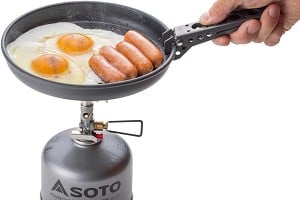
The ExpressLander is a lightweight backpacking stove that can be used to burn a number of fuels and is the latest offering from the long established Swedish company Primus. The ExpressLander offers the flexibility desired by those who intend to use the stove at home and abroad when cartridge LPgas is unavailable, in extremely cold conditions or prefer the economy of unleaded fuel or white gas. The ExpressLander also has the ability to burn paraffin and kerosene when required, but is not supplied with a fuel bottle - this must be purchased separately.
I have owned and used regularly a Primus cartridge gas burning backpacking stove with a built-in ignition element for around 15 years. It has performed without any problems and absolutely no maintenance, and therefore as far as build quality is concerned I assume that the ExpressLander is manufactured to the same high standard - it certainly looks and feels to be equally well engineered, the steel and aluminium structure being not dissimilar to my older Primus model.
"Multi-fuel burning stoves such as the ExpressLander are not the simplest bits of kit. When considering purchasing one a good deal of weighing up of the pros and cons should be undertaken."However, at the outset it has to be said that multi-fuel burning stoves such as the ExpressLander are not the simplest bits of kit, and when considering purchasing one a good deal of weighing up of the pros and cons should be undertaken. There is no doubt that cartridge gas burning stoves are the easiest and cleanest to use and that adding the multi-fuel burning option is a considerable add-on in both weight and inconvenience. The Primus Express Spider just uses LPgas and is considerably lighter (without the fuel pump) – see this news item. The ExpressLander has a stand-apart burner on a three-footed stand that quickly fans out to provide a stable platform. The burner is attached to the fuel source by a steel covered pipe the end of which has a universal thread and heat adjuster for attachment to a gas cartridge or fuel pump and bottle. I found the instruction leaflet supplied difficult to follow and, had I not owned a stove before, I think that I would have really struggled to get it going. Perhaps the most crucial point lost in the instructions was the identification of the correct jet to be fitted dependant upon the fuel used (2 are supplied one for cartridge gas and one for petrol - for reference the number of the jet is stamped on the end of the jet itself). A separate jet must be fitted when using kerosene/paraffin and is not supplied as standard.
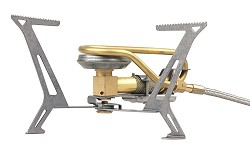
Features:
- Weight: 176g
- Output: 1500 W / 5200 BTU/h
- Boiling time: 4.5 mins per litre
- Burn time: 120g/h
- Dimensions: 4.1”x3.2”x2”
- Ignition: Manual
- Suitable for: 1-4 people
- More info on the Rosker website
The ExpressLander - as a gas cartridge burner.
The burner and fuel pipe are light - 175g - as is the aluminium reflector/windshield protector and coupled with a small gas cartridge provides a good lightweight stove option, or with a larger cartridge the weight is easily split between two people. The setting up of the ExpressLander in this mode is very quick, clean and straightforward. In use the flame is instantly available and under normal circumstances (out of the wind) a litre of water comes to the boil in around 4.45secs (my test).
"Setting up the ExpressLander in this mode is very quick, clean and straightforward."
The heat from the burner is regulated via a twist knob that has plus and minus symbols on it - the heat output is easily manipulated. The pre-heat tube is a vital addition for cold weather usage, keeping the gas in a gaseous state prior to burning. The stove cools rapidly after use and can be quickly dismantled and stowed in the bespoke carrying pouch supplied. It should be noted that the weight is heavier than that of many lightweight dedicated gas burners.
The ExpressLander - as a multi-fuel burner
The ExpressLander comes with a separate jet that must be fitted (tools supplied) before it is used to burn unleaded petrol or white gas. In order to burn kerosene or paraffin another jet is required and this must be purchased separately. The fuel pump supplied is robust and the pump handle is made of steel, however the fuel bottle itself (ranging in capacities from .35 to 1.5 litres) must be purchased separately costing from around £5 to £17.
"Setting up the stove is fairly involved although the connection of the various parts themselves and the operation of the stove once assembled is excellent."Setting up the stove is fairly involved although the connection of the various parts themselves and the operation of the stove once assembled is excellent and would appear to be very robust. Priming the stove before use takes around 2 minutes and 15 seconds and once primed a litre of water comes to a full boil in around 5 min. Control of the heat is not easy being by the fuel regulator and is not as sensitive as when used with the gas cartridge set-up. In order for the stove to work the fuel bottle must be placed with the ON marker facing upwards. When finished with, to clean out the fuel supply pipe the bottle must be turned over into the OFF position and the fuel burnt off from inside the pipe before packing up – a very useful feature. The jets are easily removed for cleaning with the supplied tools.
Summary
Overall the ExpressLander is an impressive bit of kit that should be considered by all those looking to backpack with the convenience of just a small gas canister, but also want the flexibility of using it as a multi-fuel burner where cartridge gas is not available or for use in very cold conditions/economy. Setting up initially is not helped by the instructions supplied and be very careful not to mis-place the fuel jets, tools and instructions, which tell you which jet number is to be used with which fuel.



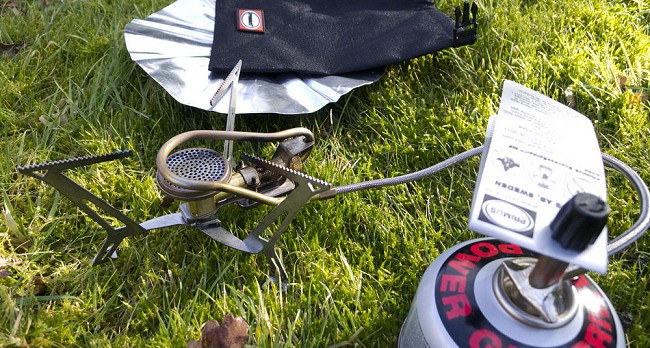
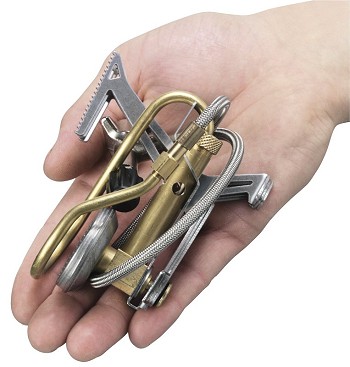
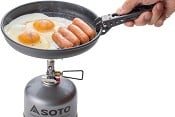
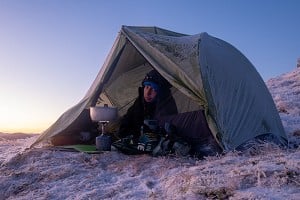

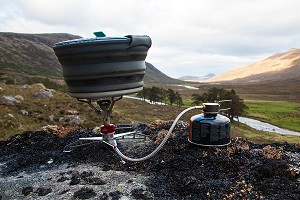
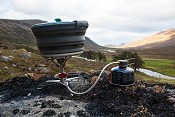
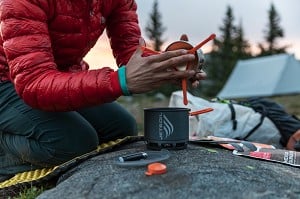
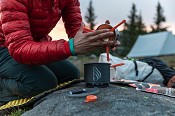
Comments